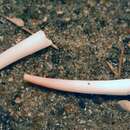en
names in breadcrumbs


Scaphopods do not have a heart, gills or vessels for circulation. Instead, circulation is through simple hemolymph sinuses and gas exchange takes place across the mantle and body surface.
The scapopod captacula may have tactile receptors, but this is unknown. Scaphopods have lost eyes, tentacles and osphridia found in other molluscs. The buccal cavity has a sub-radular (below the radula) organ which may be chemoreceptive.
Perception Channels: tactile ; chemical
No scaphopods are currently listed or given special status.
After fertilization, the egg develops into a free-swimming trocophore larvae, then a bilaterally symmetrical veliger. The veliger usually metamorphoses in 5-6 days. At this point it becomes benthic.
Development - Life Cycle: metamorphosis
There are approximately 900 species of Scaphopoda, commonly called tusk shells.
Shells of the genus Dentalium were culturally significant with Pacific Northwest natives (Amerinds)until the late 1800s. The shells were collected on strings and used as necklaces and money.
Positive Impacts: body parts are source of valuable material
Scaphopods selectively feed on sediments, although the importance of this in the ecosystem is unknown. Hermit crabs are known to use the shells.
Scaphopods are selective deposit feeders, mainly feeding on microscopic organisms, particularly diatoms and foraminiferans. Each tentacle of the capatula has an adhesive know at the tip to capture prey. Tentacular cilia brings smaller particles back to the scaphopod mouth. The tentacles retract to bring larger items to the mouth. The radula is used to break down prey. Food is digested extracellularly in the stomach, then travels from the stomach to intestine. Waste is expelled into mantle cavity through the anus.
Primary Diet: omnivore
Scaphopods are found in marine regions around the world.
Biogeographic Regions: indian ocean; atlantic ocean ; pacific ocean ; mediterranean sea
Scaphopods are all marine species whose habitat ranges from shallow sub-littoral areas up to waters that are 4570 m deep. Most scaphopods are found in waters greater than 6 m. Scaphopods burrow in sediments ranging from muds to medium-coarse gravel. The two orders of this group may have slightly differing burrowing behaviors. Individuals in the Gadilida may burrow up to 30 cm in captivity. Many species in the Dentaliida burrow with the concave side just below the substrate.
Habitat Regions: saltwater or marine
Aquatic Biomes: benthic ; coastal
Other Habitat Features: intertidal or littoral
Scaphopod shells usually have four layers, and these are used for identification. The shell is curved, tubular, and shaped like an elephant tusk. Most average 3 to 6 cm long, but can range from 4 mm to 15 cm. Fossils show specimens 30 cm long.
The scaphopod shell is open at both ends. The wider end of the shell where the head and foot extends out is the anterior end. The posterior is the narrow end of the shell which usually is at or below the substrate.
The shell surrounds a large mantle cavity, and wraps around the viscera to form a tube. The mantle cavity goes along ventral side to a smaller opening at the other end. No ctenidia are present, and gas exchange is through the mantle surface. Cilia an currents move water thorugh posterior aperature. Occasional muscular contractions expell water from the posterior end of the shell.
The head is a short, conical projection (probosicis) with a mouth. Lobes on each side of the head have threadlike tentacles, called captacula, which are used to capture food.
Other Physical Features: ectothermic ; heterothermic ; homoiothermic; bilateral symmetry
Scaphopods are fed on by fish and crabs. Their burrowing behavior is thought to keep them from predators.
Known Predators:
Scaphopods are gonochoristic or dioecious. Eggs are released singly through the right nephridium. Sperm is also released through the nephridium. Eggs are planktonic and fertilization is external.
Key Reproductive Features: gonochoric/gonochoristic/dioecious (sexes separate); sexual ; fertilization (External ); oviparous
There is no parental investment after release of gametes.
Parental Investment: pre-fertilization (Provisioning)